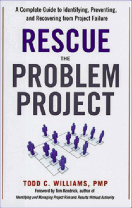Turnaround specialist Todd Williams has worked with dozens of companies in multiple industries resuscitating failing projects. In his recently published book, Rescue the Problem Project: A Complete Guide to Identifying, Preventing, and Recovering from Project Failure, he explains techniques for identifying the root causes of the trouble, steps for putting projects back on track—audit the project, analyze the data, negotiate the solution and execute the new plan. The book includes more than 60 real-world examples of what works, what doesn’t and why.

Williams said that his proven solutions always adhere to four lessons:
- Quit searching for someone to blame. It does not solve the problem.
- Don’t fire the team. Don’t fire anyone. Just work with them.
- Real data are your friend. Get everyone to confront the facts.
- Get people moving in the right direction. Focus them on productive work. You can’t shut them down forever.
“It’s not as simple as simply firing the existing leader and getting a new one,” Williams said. “You have to be willing to really work with the stakeholders—the actual people who are affected. The solution always lies with the team, the process and the customers—the actual people who rely on it.”
Some of his advice on how to turn a problem project around:
Acknowledge the problem—Denial is the biggest problem in trying to solve a project’s issues. People always think they can make it better in just a couple more weeks. They can’t. They need to re-evaluate the project’s goals.
Acknowledging a project’s problem is just like any other 12-step process—the first step is to admit you are powerless and need help. Whether there are four or 10 steps after that are solely dependent on the experience of the people you ask to help you.
Audit your projects—Too many project managers are overly passionate about their project. They root for it like a high school cheerleader. Their job is not to advocate for the project, but to be objective—passionately dispassionate—and determine what is working and what to get rid of.
Analyze the data and develop solutions—The answer to the project’s issues are in the team. Talk to them, learn from them. It is the only time in life where you can take credit for everyone else’s ideas. If you tell the bosses that their team knew how to do it all along, you will get fired and the project will never get fixed. Don’t search for blame. If you find it, it will only give you fleeting pleasure, and you still need to fix the problem. It is much like peeing in a dark pair of pants, you get a warm feeling, no else notices, and you have a horrid mess to clean up.
Identify root causes and deploy changes effectively—Data hold the answer. Numbers are truthful little bastards, squeeze them hard enough and they will tell you the truth. It is integral to their job.
Select the correct methodology—“We have always done it that way” is the cry of the person without enough drive or imagination to build something new and innovative. This mentality keeps companies like mine in business. There is no shortage of stupid people continuing to do stupid things.
Negotiate the solution—Project recovery requires changes. The actions needed to bring an out-of-control project back in line necessitate stakeholder involvement to change the scope, schedule, budget or all three. Identify the people who are affected by these changes and negotiate the solution with them.
Prevent future failure—The saying, “a stitch in time saves nine,” has never been more correct. Control scope, document the decisions, give the users what they need, not what they want. People are quick to tell you the solution; they are slow to figure out if it is the correct solution.
There are three parameters that control a project—scope, schedule and budget. You can set two of those attributes, but the project manager will tell you the other. Try to enforce all three and you have the definition of a failure waiting to happen.
Technology makes almost anything more efficient. However, before you apply it, have the right people and the proper process in place; otherwise, you will get into trouble just as badly as before, only faster and much more efficiently.
How do you avoid problems in the first place? Williams said, “Build the right team, start the project on the correct premise, understand and mitigate risk, and finally, accept and manage change.”
Rescue the Problem Project: A Complete Guide to Identifying, Preventing, and Recovering from Project Failure, Todd C. Williams. List $32.95. AMACOM Books, hardcover, ISBN 978 978-0-814-41682-2. www.rescuetheproblemproject.com.









